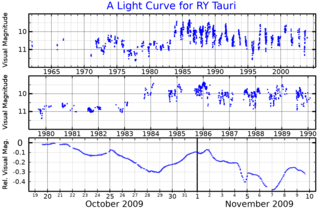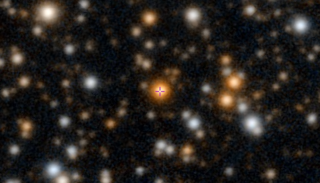List
| Star | Image | Diameter | Distance (ly) | First imager | Year | Notes | |
|---|---|---|---|---|---|---|---|
| Angular (mas) | Geometric (Sun = 1) | ||||||
| Sun |  | 2000000 | 1 | 0.0000158 | Louis Fizeau and Léon Foucault [2] | 1845 | |
| Altair α Aql | | 3.2 | 1.66±0.01 (polar) 2.02±0.01 (equator) | 16.77±0.08 | CHARA array – MIRC [3] | 2006 | |
| Rasalhague α Oph A | 1.62±0.03 | 2.39±0.01 (polar) 2.87±0.02 (equator) | 48.6±0.8 | CHARA array – MIRC [4] | 2006 | ||
| Alderamin α Cep | 1.35±0.02 (polar) 1.75±0.03 (equator) | 2.20±0.04 (polar) 2.74±0.04 (equator) | 48.8±0.36 | CHARA array – MIRC [4] | 2006 | ||
| Caph β Cas | 1.70±0.04 | 3.1±0.1 (polar) 3.8±0.1 (equator) | 54.7±0.3 | CHARA array – MIRC [5] | 2007 | ||
| Regulus α Leo Aa | 1.24±0.02 | 3.2±0.1 (polar) 4.2±0.1 (equator) | 79.3±0.7 | CHARA array – MIRC [5] | 2008 | ||
| Algol β Per Aa1 |  | 0.88±0.05 | 4.13 | 93±2 | CHARA array – MIRC [6] | 2006 | stationary object in the animation |
| β Per Aa2 | 1.12±0.07 | 3 | orbiting object in the animation | ||||
| β Per Ab | 0.56±0.10 | 0.9 | Observed radius of Algol Ab is an instrumental artifact, caused by bandwidth smearing. Actual radius is 1.73 ± 0.33 R☉. | ||||
| Alkaid η UMa | 0.834±0.060 | 2.86±0.21 | 103.9±0.8 | CHARA array [7] | 2012 | ||
| Markab α Peg | 1.052±0.066 | 4.62±0.29 | 133±1 | CHARA array [7] | 2012 | ||
| Elnath β Tau | 1.09±0.076 | 4.82±0.34 | 134±2 | CHARA array [7] | 2012 | ||
| σ Gem A | 2.425 | 10.1±0.4 | 126±2 | CHARA array/MIRC [8] | 2011–2012 | The star contains starspots on its surface | |
| ζ And Aa | 2.502±0.008 | 15.0±0.8 (polar) | 189±3 | CFHT [9] [10] | 1996 | First direct imaging of starspots on a star outside the Solar System. | |
| R Dor |  | 57±5 | 370±50 | 204±9 | New Technology Telescope [11] | 1993 | 2nd largest known star by apparent diameter in Earth's sky, after the Sun. |
| Mira ο Cet A |  | 28.9–34.9 [12] | 332–402 [12] | 420 | Hubble – FOC [13] | 1997[ citation needed ] | |
| Polaris α UMi Aa | 3.143±0.027 | 46.27±0.42 | 446±1 | CHARA array| [14] | 2024 | ||
| T Lep |  | 5.8 15 for molecular layer | 100 | 500 | Very Large Telescope – VLTI [15] /AMBER [16] | 2009[ citation needed ] | |
| π1 Gru |  | 21 [17] | 370 [17] | 535 [17] | Very Large Telescope – VLTI/PIONIER [18] | 2017[ citation needed ] | First directly observed granulation patterns on a star's surface outside the Solar System. |
| Antares α Sco A |  | 41.3±0.1 | 680 [19] | 553 [20] | Very Large Telescope – VLTI/AMBER [21] [22] | 2017[ citation needed ] | |
| Betelgeuse α Ori |  | 50 | 640 [23] –764 [24] | 643±146 | Hubble – GHRS [1] | 1995 | First star with a resolved image outside the Solar System. |
| Sheliak β Lyr Aa |  | 0.46 | 6 | 960±50 | CHARA array – MIRC [25] | 2007 | Both Aa1 and Aa2 are visible in the animation. |
| θ1 Ori C | | 0.2 | 10.6±1.5 | 1400 | Very Large Telescope – AMBER [26] | 2009 | In the image, the right inset is θ1 Ori C and the left inset is θ1 Ori F. |
| θ1 Ori F | Very Large Telescope – VLTI/GRAVITY [27] | 2016[ citation needed ] | |||||
ε Aur B | 2.27 | 3.7±0.7 | ca. 2000 | CHARA array – MIRC [28] | 2009 | Supergiant with an eclipsing companion surrounded by a massive, opaque debris disk | |
| RW Cephei |  | 2.45 | 1100±44 [29] | 11000+4600 −2600–22000+5200 −3300 | CHARA array – MIRC-X and MYSTIC [30] | 2022 | Hypergiant star currently undergoing a great dimming event |
| HR 5171 Aa |  | 4.1±0.8 | 1060–1160 [31] | 11740±1630 | Very Large Telescope – VLTI/PIONIER [32] | 2014 | Eclipsing and potential contact binary yellow hypergiant |








